Northeast India’s ‘Joha’ Rice: A Promising Solution for Diabetes and Heart Disease Prevention
Exploring the Potential of Joha Rice Variety in Northeast India
Rice, a dietary staple in many Asian countries, provides sustenance to a significant portion of the global population. However, individuals with diabetes and prediabetes often have to forgo this beloved grain due to the high glycemic index of processed white rice found on supermarket shelves. Luckily, recent scientific findings have brought attention to a culinary gem: an indigenous Indian rice variety called Joha, which shows remarkable promise not only in managing type 2 diabetes but also in preventing heart ailments.
Joha Rice: An Aromatic Winter Paddy Crop
Joha rice is a small-grain aromatic winter paddy crop predominantly cultivated in Northeast India, particularly in Assam. For centuries, people in the region have been utilizing this variety as a healthier alternative to regular white rice. Reports of its anti-diabetic and cardioprotective properties have spurred researchers at Guwahati’s Institute of Advanced Studies in Science and Technology (IASST) to delve into its unique characteristics.
Uncovering the Health Benefits of Joha Rice
Through in vitro laboratory analysis, scientists at IASST discovered two unsaturated fatty acids present in Joha rice: linoleic acid (omega-6) and linolenic acid (omega-3). These essential fatty acids, which the human body cannot produce on its own, offer a multitude of physiological benefits. In particular, omega-3 fatty acids have shown the ability to combat various metabolic diseases, including diabetes, heart ailments, and even cancer.
Notably, scented Joha rice exhibits a well-balanced ratio of these essential compounds compared to other widely consumed scented rice varieties. Furthermore, Joha rice is rich in bioactive compounds such as antioxidants, flavonoids, and phenolics, known for their efficacy in lowering blood sugar levels and protecting against heart disease.
Promising Results: Lowering Blood Glucose Levels and More
Laboratory studies conducted on diabetic rats showcased the effectiveness of a Joha rice-based diet in actively reducing blood glucose levels and increasing insulin levels when compared to diets based on other rice varieties. Surprisingly, rats on the Joha rice diet demonstrated the ability to recover from diabetes and prevent its onset.
Addressing India’s Diabetes Burden
India faces a growing diabetes burden, with estimates projecting a staggering figure of 134 million cases by 2045, according to the International Diabetes Federation. Therefore, the next crucial step involves popularizing this lesser-known, healthy rice variety.
Scientists highlight not only the protective benefits but also the flavors and tender texture of Joha rice. With support from policymakers, incentivizing its cultivation can pave the way for Joha rice to transition from a favored choice in laboratories to a preferred option for households.
A Healthier Rice Alternative
Joha rice represents a promising solution in the fight against diabetes and heart disease. Its unique composition, coupled with its sensory appeal, positions it as a valuable addition to the dietary landscape. By embracing Joha rice and promoting its cultivation, Northeast India can lead the way in offering a healthier rice alternative that benefits both the local population and the broader fight against chronic diseases.
As research continues and awareness spreads, the potential of Joha rice to improve health outcomes grows stronger. With concerted efforts, this indigenous rice variety can make a significant impact in the battle against diabetes and heart disease, ultimately improving the well-being of individuals and communities.




